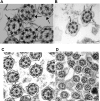Primary ciliary dyskinesia: evaluation using cilia beat frequency assessment via spectral analysis of digital microscopy images
- PMID: 21551013
- PMCID: PMC3137538
- DOI: 10.1152/japplphysiol.00629.2010
Primary ciliary dyskinesia: evaluation using cilia beat frequency assessment via spectral analysis of digital microscopy images
Abstract
Ciliary beat frequency (CBF) measurements provide valuable information for diagnosing of primary ciliary dyskinesia (PCD). We developed a system for measuring CBF, used it in association with electron microscopy to diagnose PCD, and then analyzed characteristics of PCD patients. The CBF measurement system was based on power spectra measured through digital imaging. Twenty-four patients suspected of having PCD (age 1-19 yr) were selected from a group of 75 children and adolescents with pneumopathies of unknown causes. Ten healthy, nonsmoking volunteers (age ≥ 17 yr) served as a control group. Nasal brush samples were collected, and CBF and electron microscopy were performed. PCD was diagnosed in 12 patients: 5 had radial spoke defects, 3 showed absent central microtubule pairs with transposition, 2 had outer dynein arm defects, 1 had a shortened outer dynein arm, and 1 had a normal ultrastructure. Previous studies have reported that the most common cilia defects are in the dynein arm. As expected, the mean CBF was higher in the control group (P < 0.001) and patients with normal ultrastructure (P < 0.002), than in those diagnosed with cilia ultrastructural defects (i.e., PCD patients). An obstructive ventilatory pattern was observed in 70% of the PCD patients who underwent pulmonary function tests. All PCD patients presented bronchial wall thickening on chest computed tomography scans. The protocol and diagnostic techniques employed allowed us to diagnose PCD in 16% of patients in this study.
Figures



References
-
- Bhalla M, Turcios N, Aponte V, Jenkins M, Leitman BS, McCauley DI, Naidich DP. Cystic fibrosis scoring system with thin-section CT. Radiology 179: 783–788, 1991. - PubMed
-
- Boek WM, Keles N, Graamans K, Huizing EH. Physiologic and hypertonic saline solutions impair ciliary activity in vitro. Laryngoscope 109: 396–399, 1999. - PubMed
-
- Bush A. Primary ciliary dyskinesia. Acta Otorhinolaryngol Belg 54: 317–324, 2000. - PubMed
-
- Bush A, Cole P, Hariri M, Mackay I, Philips G, O'Callaghan C, Wilson R, Warner JO. Primary ciliary dyskinesia: diagnosis and standards of care. Eur Respir J 12: 982–988, 1998. - PubMed
Publication types
MeSH terms
LinkOut - more resources
Full Text Sources
Research Materials

